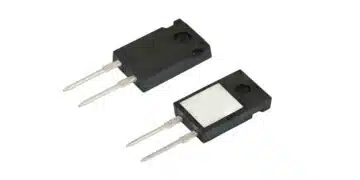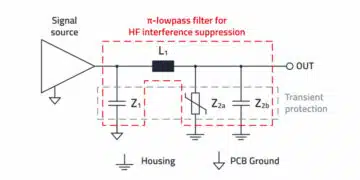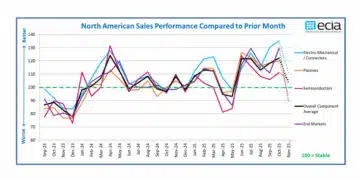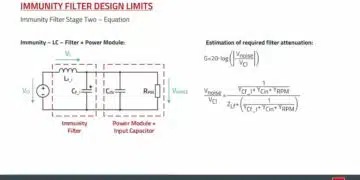Bartosz Gackowski at col from SDU University in Denmark published their paper “Enhancing energy density in thin-film nanocomposite dielectric capacitors through surface functionalization of nanoparticles” in Energy Conversion and Management: X Journal.
Introduction
Thin-film dielectric capacitors are essential components in modern power electronics, offering high-frequency stability and rapid charge-discharge capabilities. However, their energy density remains constrained by the intrinsic properties of polymer dielectrics such as polypropylene (PP) used in film capacitors.
This article explores a novel approach to enhancing energy density through surface functionalization of barium titanate nanoparticles (BTNs), integrated into PP matrices using a gel-based spin-coating method. Barium titanate is a common ferroelectric dielectric material used by class II MLCC ceramic capacitors.
Key Points
- Functionalization of BTNs significantly improves dielectric constant and breakdown strength.
- Surface treatments include hydroxylation, organic modifiers, polymer coating, and grafting.
- Energy density increased by up to 308% compared to untreated BTN composites.
- Polymer coating and grafting yielded the highest dielectric strength and energy density.
- Applications span electric vehicles, grid storage, and high-voltage converters.
Extended Summary
Chapter 1: Materials and Functionalization Techniques
BTNs were treated using four distinct methods: hydroxylation (H2O2 or HNO3), organic surface agents (dopamine, silane, phosphorous acid, etc.), polymer coating with PP, and grafting with PPgMA. These treatments aimed to improve nanoparticle dispersion, reduce agglomeration, and tailor interfacial properties for enhanced dielectric performance.
Chapter 2: Fabrication of Nanocomposite Capacitors
Functionalized BTNs were dispersed in a PP gel and spin-coated onto silver-coated glass substrates. A layered structure was employed to mitigate short-circuit risks from agglomerates. Aluminium top electrodes were deposited to complete the capacitor structure. Dielectric thicknesses remained below 1 µm, ensuring compact device profiles.
Chapter 3: Chemical and Structural Analysis
XPS and EDX analyses confirmed successful surface modification, with increased oxygen and carbon content correlating to improved dispersion and interfacial bonding. Dopamine-treated BTNs exhibited the highest carbon concentration, indicating robust surface coverage. FTIR spectra revealed functional group incorporation, supporting the chemical bonding hypotheses.
Chapter 4: Dispersion and Agglomeration Control
Dynamic Light Scattering (DLS) showed that hydroxylation reduced particle size and agglomeration. Polymer-coated and grafted nanoparticles exhibited increased hydrodynamic diameters, suggesting shell formation. Proper dispersion was critical for maintaining high breakdown strength and uniform electric field distribution.
Chapter 5: Dielectric Performance Metrics
Capacitance, dielectric constant, and breakdown strength were measured across all samples. Devices with maleic anhydride and dopamine-modified BTNs showed up to 47% increase in capacitance. Polymer-coated BTNs achieved the highest breakdown strength (108% improvement), resulting in energy densities up to 5.2 J/cm3.
| Sample | Dielectric Constant (εr) | Breakdown Strength (MV/m) | Energy Density (J/cm3) |
|---|---|---|---|
| Neat PP | 2.0 | 700 | 1.3 |
| BTN + Maleic Anhydride | 3.81 | 377 | 2.4 |
| BTN + Dopamine | 3.5 | 412 | 2.0 |
| BTN + PP Coating | 3.1 | 608 | 5.2 |
| BTN + PPgMA Grafting | 2.9 | 480 | 3.1 |
Chapter 6: Applications in Power Electronics
Enhanced nanocomposite capacitors are ideal for high-voltage converters, electric vehicles, and grid storage systems. Their compact size and high energy density support integration with wide-bandgap semiconductors (SiC, GaN), enabling efficient, lightweight designs. Hybrid capacitor systems combining electrolytic and film capacitors benefit from improved ripple current handling and extended lifespan.
Conclusion
This study demonstrates that surface functionalization of BTNs is a critical strategy for improving the energy density of PP-based nanocomposite capacitors. Among the tested methods, polymer coating and grafting yielded the most significant performance gains. These findings pave the way for next-generation capacitors in high-efficiency power electronics, offering reduced size, weight, and enhanced reliability.
Read the full article at the link:
Bartosz Mikolaj Gackowski, Mohit Sharma, Alexandru Valuta, Thomas Ebel, William Greenbank,
Enhancing energy density in thin-film nanocomposite dielectric capacitors through surface functionalization of nanoparticles,
Energy Conversion and Management: X, Volume 28, 2025, 101260, ISSN 2590-1745,
https://doi.org/10.1016/j.ecmx.2025.101260.
(https://www.sciencedirect.com/science/article/pii/S2590174525003927)































